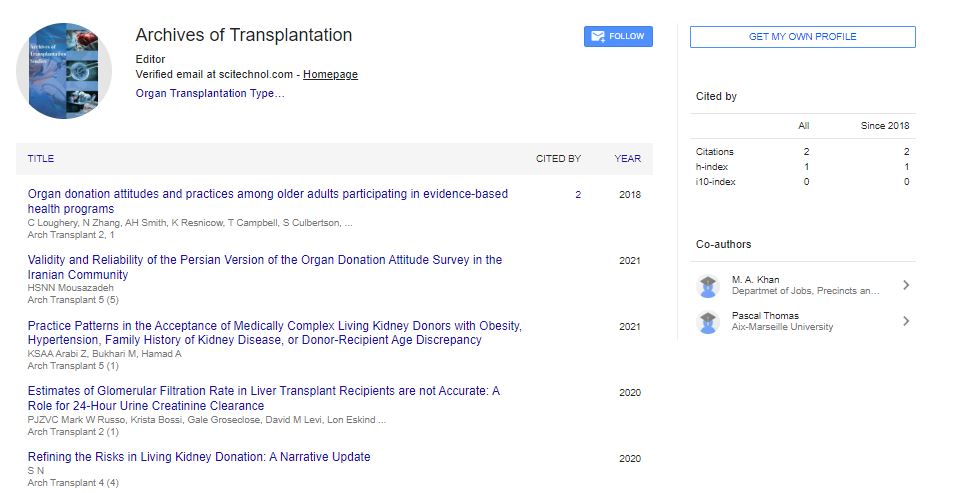Opinion Article, Arch Transplant Vol: 7 Issue: 4
Examining the Role of Domino Transplants in Organ Donation
David Carmen*
1Department of Medicine, Emory University School of Medicine, Atlanta, United States of America
*Corresponding Author: David Carmen,
Department of Medicine, Emory
University School of Medicine, Atlanta, United States of America
E-mail: david_carmen@eusm11.edu
Received date: 22 November, 2023, Manuscript No. AT-24-124970;
Editor assigned date: 24 November, 2023, PreQC No AT-24-124970 (PQ);
Reviewed date: 11 December, 2023, QC No. AT-24-124970;
Revised date: 19 December, 2023, Manuscript No. AT-24-124970 (R);
Published date: 26 December, 2023, DOI: 10.4172/AT.1000152
Citation: Carmen D (2023) Examining the Role of Domino Transplants in Organ Donation. Arch Transplant 7:4.
Description
Organ transplantation has transformed the landscape of medical care, providing a lifeline to individuals facing organ failure. Among the innovative approaches to expand the donor pool and optimize the use of organs, domino transplants have emerged as a remarkable solution. It delves into the intricacies of domino transplants, examining their role, types, and the profound impact they have on the field of organ donation. Domino transplants, also known as paired or chain transplants, represent a dynamic and interconnected approach to organ donation. Unlike traditional one-to-one organ donations, domino transplants involve a chain reaction of altruistic giving. The process typically begins with an altruistic donor who is willing to donate an organ without a specific recipient in mind.
This initial donation sets off a chain of transplants where the donated organ is used to benefit a recipient, and the recipient's incompatible but willing donor contributes an organ to the next recipient in line. This cascading effect continues, developing a chain of interconnected donations that maximizes the impact of a single act of generosity. In a paired kidney exchange, two or more incompatible donor-recipient pairs are matched with each other. For example, if a donor from pair A is compatible with a recipient from pair B and vice versa, a paired exchange ensures that both recipients receive compatible kidneys. This type of exchange can create a chain of transplants involving multiple pairs.
Chain transplants take the idea of domino transplants further by involving more than two pairs of donors and recipients. The initial altruistic donor's organ sets off a chain, with each subsequent recipient's incompatible donor contributing to the next link in the chain. This sequential exchange can potentially involve multiple transplant surgeries and save numerous lives. Non-directed donor chains start with an altruistic donor who chooses to donate without having a specific recipient in mind. The chain then unfolds as each recipient's incompatible donor contributes to the next link. This type of domino transplant emphasizes the power of selfless giving and its transformative impact on the lives of multiple recipients.
Domino transplants provide a strategic approach to maximize the utilization of available organs. By enabling multiple transplants from a single altruistic donor, the donor pool is effectively expanded, addressing the persistent challenge of organ shortages. Matching incompatible donor-recipient pairs in a domino transplant increases the chances of compatibility. This innovative approach ensures that more individuals find suitable donors, enhancing the overall success rates of transplant surgeries. Domino transplants promote efficiency in organ utilization by orchestrating a chain of donations.
This means that organs are directed to recipients who might not have found a suitable match through traditional one-to-one transplantation methods. The altruistic nature of domino transplants adds a profound layer to the organ donation process. Individuals who choose to be non-directed donors or participate in paired exchanges contribute to a chain of generosity, developing a positive and transformative impact on multiple lives. While domino transplants present a promising solution, they are not without challenges. Coordinating a chain of surgeries involving multiple donors and recipients requires meticulous planning. Additionally, logistical considerations, ethical concerns, and ensuring fair and equitable allocation of organs pose challenges that transplant programs must navigate.
The role of domino transplants in organ donation is likely to evolve with ongoing advancements in medical science and transplantation practices. Innovations in technology, improved matching algorithms, and enhanced coordination between transplant centers may further streamline the process and expand the reach of domino transplant programs. As medical analysts and professionals continue to explore ways to overcome challenges, domino transplants may become an even more integral part of organ donation strategies, providing hope to a growing number of individuals awaiting life-saving transplants.
Conclusion
In conclusion, domino transplants exemplify the interconnectedness of humanity in the realm of organ donation. By developing chains of giving and receiving, these innovative approaches to transplantation address vital challenges in organ shortages and compatibility. As one can continue to examine the role of domino transplants in organ donation, one can recognize the transformative potential of these interconnected acts of generosity, providing a beacon of hope for individuals in need of life-saving organ transplants.
 Spanish
Spanish  Chinese
Chinese  Russian
Russian  German
German  French
French  Japanese
Japanese  Portuguese
Portuguese  Hindi
Hindi 